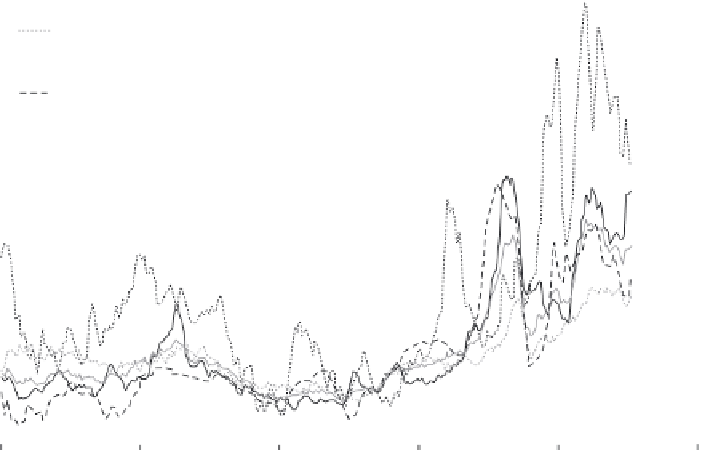Agriculture Reference
In-Depth Information
450
Cereals index
Sugar index
Meat index
Food index
Oils index
Dairy index
400
350
300
250
200
150
100
50
2015
1990
1995
2000
2005
2010
Year
FIGURE 5.5
FAO's food price indices, including food, cereals, sugar, oil, meat and dairy (source:
data from the Food and Agriculture Organization).
cereals index, a smaller set of commodity prices than used in these three indices would suffice
to observe largely the same general price trends. A regression of month-to-month changes in
the FAO cereals price index on month-to-month changes in three export cereal price quotes
(no. 2 hard red winter wheat - from the Gulf, no. 2 yellow maize - from the Gulf, and Thai
rice 100 percent B - from Bangkok) shows that these three prices explain about 85 percent
of the variation in that index (FAO, 2013).
The focus of the analysis is to understand how the FAO cereals index relates to prices of
locally grown commodities in small, isolated developing country markets, such as Zinder,
Niger. This is a small, remote, rural community situated in the desert margin region of West
Africa approximately 150 miles north of Kano, Nigeria. Can we assume that the price in
Zinder goes up when the FAO food price index goes up? Since Zinder is a small community
of people who mostly are involved in agricultural activities, is information about international
price dynamics enough to move local food prices, since it takes months for actual food to
arrive in Zinder from the international community? To determine how related local food
prices are to global food prices, two elements must be explored. First, we need to determine
if the local food consumed is similar to the food consumed by the poorest and food insecure
in each country. In West Africa, poor rural farmers raise and eat the grains millet and sorghum,
the root crops cassava (manioc) and the legumes cowpeas and peanuts. Most rural households
cannot afford to eat imported maize, rice or wheat, the goods included in the FAO cereals
index. Thus the mismatch between the locally relevant goods and the goods in the FAO
cereals index is a concern.






Search WWH ::

Custom Search